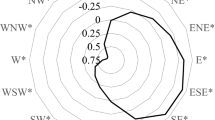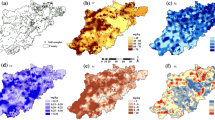Abstract
Thyroid cancer (TC) incidence in China has increased rapidly in recent years. Hangzhou is one of the areas with the highest TC incidence in China. However, the composite space–time variation and risk factors of TC are rarely investigated. We acquired 7147 TC cases from 2008 to 2012 in Hangzhou. Descriptive statistics were employed to compare the incidence disparities in different sub-populations. Geographical information systems were used to create spatial distribution maps. Hotspot analysis was applied to detect high/low incidence clusters, and the GeogDetector model was implemented to investigate the relationship between TC incidence and environmental factors. TC incidence in Hangzhou increased dramatically from 2008 to 2012: a noticeable 244.9 % increase, from 10.04 to 34.63 per 100,000 individuals, with a female to male ratio of 3.0, an urban to rural ratio of 3.2 and iodine sufficient to iodine deficient ratio of 3.5. Significantly high TC cluster was detected in the northeast area of Hangzhou. Elevation was found to be the most powerful determinant of TC distribution, followed by soil parent materials and slope. TC incidence decreased as elevation and slope increased. Concerning soil parent materials, deposited materials were generally linked to higher TC incidence than were eluvium ones. The spatial/temporal pattern of TC incidence is affected by geomorphology and soil property variations. Excessive iodine exposure may be a TC risk factor. Health research and management should pay sufficient attention to the improved understanding and prediction of the composite space–time distribution of the quickly increasing TC incidence described in this study.






Similar content being viewed by others
References
Allen NE, Beral V, Casabonne D et al (2009) Moderate alcohol intake and cancer incidence in women. J Natl Cancer Inst 101:296–305
Amin R, Burns JJ (2014) Clusters of adolescent and young adult thyroid cancer in Florida counties. Biomed Res Int 2014:832573
Amphlett B, Lawson Z, Abdulrahman GO et al (2013) Recent trends in the incidence, geographical distribution, and survival from thyroid cancer in Wales, 1985–2010. Thyroid 23(11):1470–1478
Andersson M, Takkouche B, Egli I et al (2005) Current global iodine status and progress over the last decade towards the elimination of iodine deficiency. Bull World Health Organ 83:518–525
Campbell CG, Borglin SE, Green FB et al (2006) Biologically directed environmental monitoring, fate, and transport of estrogenic endocrine disrupting compounds in water: a review. Chemosphere 65:1265–1280
Chen AY, Jemal A, Ward EM (2009) Increasing incidence of differentiated thyroid cancer in the United States, 1988–2005. Cancer 115:3801–3807
Chen ST, Hsueh C, Chiou WK et al (2013) Disease-specific mortality and secondary primary cancer in well-differentiated thyroid cancer with type 2 diabetes mellitus. PLoS One 8(1):e55179
Clero E, Doyon F, Chungue V et al (2012) Dietary iodine and thyroid cancer risk in French Polynesia: a case-control study. Thyroid 22:422–429
Dai JL, Zhang M, Hu QH et al (2009) Adsorption and desorption of iodine by various Chinese soils: II. Iodide and iodate. Geoderma 153:130–135
Dal Maso L, Bosetti C, La Vecchia C et al (2009) Risk factors for thyroid cancer: an epidemiological review focused on nutritional factors. Cancer Cause Control 20:75–86
De Benoist B, McLean E, Andersson M et al (2008) Iodine deficiency in 2007: global progress since 2003. Food Nutr Bull 29(3):195–202
Enewold L, Zhu K, Ron E et al (2009) Rising thyroid cancer incidence in the United States by demographic and tumor characteristics, 1980–2005. Cancer Epidemiol Biomark Prev 18:784–791
Fei X, Yang D, Kong Z et al (2014) Thyroid cancer incidence in China between 2005 and 2009. Stoch Environ Res Risk Assess 28:1075–1082
Fei X, Wu J, Kong Z et al (2015) Urban-rural disparity of breast cancer and socioecoomic risk factors in China. PLoS One 10(2):e0117572
Freeman LEB, Rusiecki JA, Hoppin JA et al (2011) Atrazine and cancer incidence among pesticide applicators in the agricultural health study (1994–2007). Environ Health Perspect 119:1253–1259
Galanti MR, Sparen P, Karlsson A et al (1995) Is residence in areas of endemic goiter a risk factor for thyroid cancer? Int J Cancer 61:615–621
Getis A, Ord JK (1992) The analysis of spatial association by use of distance statistics. Georg Anal 24(3):189–206
Hallquist A, Hardell L, Degerman A et al (1993) Occupational exposures and thyroid cancer: results of a case-control study. Eur J Cancer Prev 2:345–349
Hatch M, Ron E, Bouville A et al (2005) The chernobyl disaster: cancer following the accident at the chernobyl nuclear power plant. Epidemiol Rev 27:56–66
Horn-Ross PL, Morris JS, Lee M et al (2001) Iodine and thyroid cancer risk among women in a multiethnic population: the Bay Area thyroid cancer study. Cancer Epidemiol Biomark Prev 10:979–985
Kalk WJ, Sitas F, Patterson AC (1997) Thyroid cancer in South Africa: an indicator of regional iodine deficiency. S Afr Med J 87:735–738
Kilfoy BA, Zheng T, Holford TR et al (2009) International patterns and trends in thyroid cancer incidence, 1973–2002. Cancer Cause Control 20:525–531
Kolonel LN, Hankin JH, Wilkens LR et al (1990) An epidemilogic-study of thyroid-cancer in Hawaii. Cancer Cause Control 1:223–234
Leux C, Guenel P (2010) Risk factors of thyroid tumors: role of environmental and occupational exposures to chemical pollutants. Rev Epidemiol Sante 58:359–367
Li X, Xie Y, Wang J et al (2013) Influence of planting patterns on fluoroquinolone residues in the soil of an intensive vegetable cultivation area in northern China. Sci Total Environ 458:63–69
Lind P, Langsteger W, Molnar M et al (1998) Epidemiology of thyroid diseases in iodine sufficiency. Thyroid 8:1179–1183
Lope V, Pollan M, Gustavsson P et al (2005) Occupation and thyroid cancer risk in Sweden. J Occup Environ Med 47:948–957
Mack WJ, Preston-Martin S, Bernstein L et al (1999) Reproductive and hormonal risk factors for thyroid cancer in Los Angeles County females. Cancer Epidemiol Biomark Prev 8:991–997
Mikler AR, Venkatachalam S, Ramisetty-Mikler S (2007) Decisions under uncertainty: a computational framework for quantification of policies addressing infectious disease epidemics. Stoch Environ Res Risk Assess 21:533–543
Minelli G, Conti S, Manno V et al (2013) The geographical pattern of thyroid cancer mortality between 1980 and 2009 in Italy. Thyroid 23(12):1609–1618
Moon S-S, Lee Y-S, Lee I-K et al (2012) Serum thyrotropin as a risk factor for thyroid malignancy in euthyroid subjects with thyroid micronodule. Head Neck—J Sci Spec 34:949–952
Nam JJ, Gustafsson O, Kurt-Karakus P et al (2008) Relationships between organic matter, black carbon and persistent organic pollutants in European background soils: implications for sources and environmental fate. Environ Pollut 156:809–817
National Cancer Center (eds) (2008–2012) Chinese cancer registry annual report. Military Medical Sciences Publisher, Beijing
Nikiforov YE, Yip L, Nikiforova MN (2013) New Strategies in diagnosing cancer in thyroid nodules: impact of molecular markers. Clin Cancer Res 19:2283–2288
Osius N, Karmaus W, Kruse H et al (1999) Exposure to polychlorinated biphenyls and levels of thyroid hormones in children. Environ Health Perspect 107:843–849
Pellegriti G, De Vathaire F, Scollo C et al (2009) Papillary thyroid cancer incidence in the volcanic area of Sicily. J Natl Cancer 102(22):1575–1583
Persky V, Turyk M, Anderson HA et al (2001) The effects of PCB exposure and fish consumption on endogenous hormones. Environ Health Perspect 109:1275–1283
Peterson E, De P, Nuttall R (2012) BMI, diet and female reproductive factors as risks for thyroid cancer: a systematic review. PLoS One 7(1):e29177
Portier CJ, Sherman CD, Kopp-Schneider A (2000) Multistage, stochastic models of the cancer process: a general theory for calculating tumor incidence. Stoch Environ Res Risk Assess 14:173–179
Quinton JN, Catt JA (2007) Enrichment of heavy metal in sediment resulting from soil erosion on agriculture fields. Environ Sci Technol 41:3495–3500
Rahbari R, Zhang L, Kebebew E (2010) Thyroid cancer dender disparity. Future Oncol 6:1771–1779
Sikorska-Sobiegraj E, Zielinski S (2005) Adsorption of heavy metals on activated carbon in the presence of selected organic compounds. Przem Chem 84:254–256
Solan S, Wallenstein S, Shapiro M et al (2013) Cancer incidence in world trade center rescue and recovery workers, 2001–2008. Environ Health Perspect 121:699–704
Soloway LE, Boscoe FP, Schymura MJ et al (2011) Thyroid cancer incidence in highly observant Jewish neighborhoods in metropolitan New York City. Thyroid 21:1255–1261
Soto AM, Sonnenschein C (2010) Environmental causes of cancer: endocrine disruptors as carcinogens. Nat Rev Endocrinol 6:364–371
Tan J, Su Y, Fan Z et al (1989) The Atlas of endemic diseases and their environments in the People’s Republic of China, 1st edn. Science Press, Beijing
Vigneri R, Malandrino P, Vigneri P (2015) The changing epidemiology of thyroid cancer: why is incidence increasing? Curr Opin Oncol 27:1–7
Wang J, Li X, Christakos G et al (2010a) Geographical detectors-based health risk assessment and its Application in the neural tube defects study of the Heshun Region, China. Int J Geogr Inf Sci 24:107–127
Wang JF, Liu X, Christakos G et al (2010b) Assessing local determinants of neural tube defects in the Heshun Region, Shanxi Province China. BMC Public Health 10(1):52
Wu J, Wang J, Meng B et al (2004) Exploratory spatial data analysis for the identification of risk factors to birth defects. BMC Public Health 4:23
Wu J, Hu Y, Zhi J et al (2013) A 1:50 000 scale soil database of Zhejiang Province, China. Acta Pedol Sin 50:30–40
Yuan J, Chen L, Chen D et al (2008) Elevated serum polybrominated diphenyl ethers and thyroid-stimulating hormone associated with lymphocytic micronuclei in Chinese workers from an e-waste dismantling site. Environ Sci Technol 42:2195–2200
Zamora-Ros R, Rinaldi S, Biessy C et al (2015) Reproductive and menstrual factors and risk of differentiated thyroid carcinoma: the EPIC study. Int J Cancer 136:1218–1227
Zhang LR, Sawka AM, Adams L et al (2013a) Vitamin and mineral supplements and thyroid cancer: a systematic review. Eur J Cancer Prev 22:158–168
Zhang Z, Su S, Xiao R et al (2013b) Identifying determinants of urban growth from a multi-scale perspective: a case study of the urban agglomeration around Hangzhou Bay, China. Appl Geogr 45:193–202
Zhu H, Xi Q, Liu L et al (2014) Quantitative assessment of common genetic variants on FOXE1 and differentiated thyroid cancer risk. PLoS One 9(1):e87332
Zoeller RT (2005) Environmental chemicals as thyroid hormone analogues: new studies indicate that thyroid hormone receptors are targets of industrial chemicals? Mol Cell Endocrinol 242:10–15
Acknowledgments
This work was supported partially by the Commission of Science and Technology, Hangzhou (20120533Q01), the Ministry of Education, China (20120101110131) and the Department of Science and Technology, Zhejiang Province (2013C03045-2). We are very grateful to Editor in Chief Christakos and three reviewers for their useful comments and suggestions which have substantially improved this paper.
Author information
Authors and Affiliations
Corresponding author
Rights and permissions
About this article
Cite this article
Fei, X., Wu, J., Liu, Q. et al. Spatiotemporal analysis and risk assessment of thyroid cancer in Hangzhou, China. Stoch Environ Res Risk Assess 30, 2155–2168 (2016). https://doi.org/10.1007/s00477-015-1123-4
Published:
Issue Date:
DOI: https://doi.org/10.1007/s00477-015-1123-4




